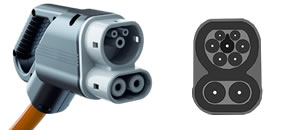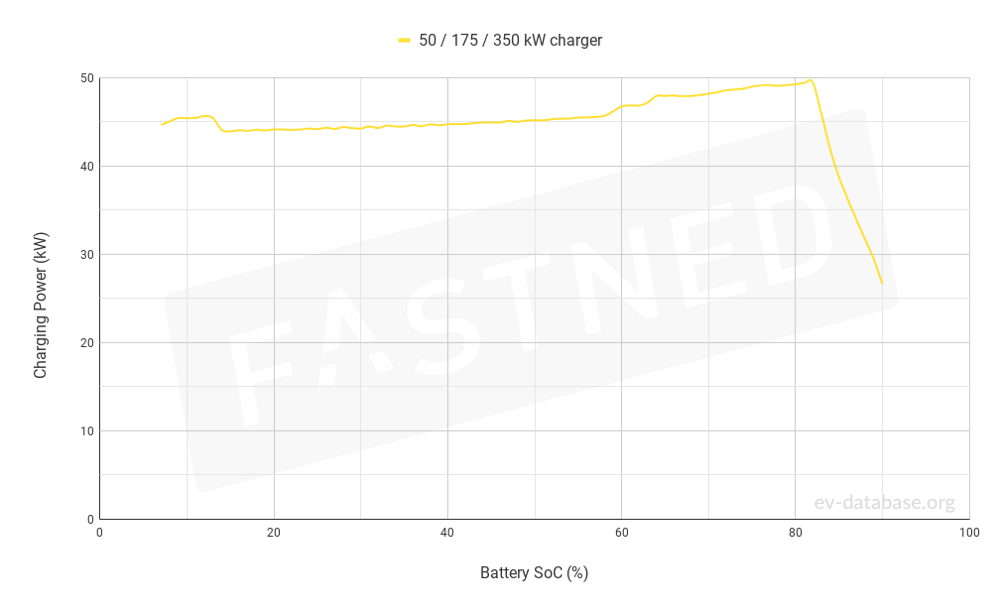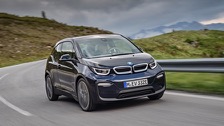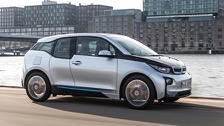Price from (last known)
£28,570
| Availability |
Not available to order |
| Available to order from |
July 2016 |
| Available to order until |
August 2017 |
| Annual VED |
£0 |
| Congestion Charge |
£11.50 |
| Insurance Group |
21 |
Price shown is the last known On The Road price: it includes VAT, first year VED, vehicle first registration fee, number plates and delivery.
The price also includes the applicable Plug-In Car Grant of £4500 at the time the vehicle was last available.
Real Range between 70 - 160 mi
| City - Cold Weather |
105 mi |
| Highway - Cold Weather |
70 mi |
| Combined - Cold Weather |
85 mi |
| City - Mild Weather |
160 mi |
| Highway - Mild Weather |
90 mi |
| Combined - Mild Weather |
120 mi |
Indication of real-world range in several situations. Cold weather: 'worst-case' based on -10°C and use of heating. Mild weather: 'best-case' based on 23°C and no use of A/C. For 'Highway' figures a constant speed of 70 mph is assumed. The actual range will depend on speed, style of driving, weather and route conditions.
Battery
| Nominal Capacity |
33.2 kWh |
| Battery Type |
Lithium-ion |
| Number of Cells |
96 |
| Architecture |
400 V |
| Warranty Period |
No Data |
| Warranty Mileage |
No Data |
| Useable Capacity |
27.2 kWh |
| Cathode Material |
NCM333 |
| Pack Configuration |
96s1p |
| Nominal Voltage |
350 V |
| Form Factor |
No Data |
| Name / Reference |
No Data |
Charging
Home / Destination
| Charge Port |
Type 2 |
| Port Location |
Right Side - Rear |
| Charge Power † |
11 kW AC |
| Charge Time (0->100 mi) † |
3 hours |
| Charge Speed † |
34 mph |
Rapid Charging
| Fastcharge Port |
CCS |
| FC Port Location |
Right Side - Rear |
| Fastcharge Power (max) |
49 kW DC |
| Fastcharge Power (10-80%) |
46 kW DC |
| Fastcharge Time (10->80 mi) |
26 min |
| Fastcharge Speed |
160 mph |
| Autocharge Supported |
Yes |
Plug & Charge
| Plug & Charge Supported |
No |
† This can only be achieved using a 3-phase grid connection. The majority of homes and charge points do not have this connection. In practice charge power will often be 7.4 kW, allowing for a charge time of 4h30m and a charge speed of 23 mph.
Bidirectional Charging (V2X / BPT)
Vehicle-to-Load (V2L)
| V2L Supported |
No |
| Max. Output Power |
- |
| Exterior Outlet(s) |
- |
| Interior Outlet(s) |
- |
Vehicle-to-Home (V2H)
| V2H via AC Supported |
No |
| Max. Output Power |
- |
| V2H via DC Supported |
No |
| Max. Output Power |
- |
Vehicle-to-Grid (V2G)
| V2G via AC Supported |
No |
| Max. Output Power |
- |
| V2G via DC Supported |
No |
| Max. Output Power |
- |
Energy Consumption
EVDB Real Range
| Range |
100 mi |
| Vehicle Consumption |
272 Wh/mi |
| CO2 Emissions |
0 g/km |
| Vehicle Fuel Equivalent |
149 mpg |
NEDC Ratings
| Range |
194 mi |
| Rated Consumption |
No Data |
| Vehicle Consumption |
140 Wh/mi |
| CO2 Emissions |
0 g/km |
| Rated Fuel Equivalent |
No Data |
| Vehicle Fuel Equivalent |
288 mpg |
Rated = official figures as published by manufacturer. Rated consumption and fuel equivalency figures include charging losses.
Vehicle = calculated battery energy consumption used by the vehicle for propulsion and on-board systems.
NOTE: The fuel equivalency figures are shown in IMPERIAL MPG. Figures in US MPG will differ significantly.
Real Energy Consumption between 170 - 389 Wh/mi
| City - Cold Weather |
259 Wh/mi |
| Highway - Cold Weather |
389 Wh/mi |
| Combined - Cold Weather |
320 Wh/mi |
| City - Mild Weather |
170 Wh/mi |
| Highway - Mild Weather |
302 Wh/mi |
| Combined - Mild Weather |
227 Wh/mi |
Indication of real-world energy use in several situations. Cold weather: 'worst-case' based on -10°C and use of heating. Mild weather: 'best-case' based on 23°C and no use of A/C. For 'Highway' figures a constant speed of 70 mph is assumed. The energy use will depend on speed, style of driving, climate and route conditions.
Safety (Euro NCAP)
| Safety Rating |
|
| Adult Occupant |
86% |
| Child Occupant |
81% |
| Rating Year |
2013 |
| Vulnerable Road Users |
57% |
| Safety Assist |
55% |
For more details on the safety rating of this vehicle, visit
euroncap.com
Dimensions and Weight
| Length |
3999 mm |
| Width |
1775 mm |
| Width with mirrors |
No Data |
| Height |
1578 mm |
| Wheelbase |
No Data |
| Weight Unladen (EU) |
1320 kg |
| Gross Vehicle Weight (GVWR) |
1670 kg |
| Max. Payload |
425 kg |
| Cargo Volume |
260 L |
| Cargo Volume Max |
1100 L |
| Cargo Volume Frunk |
No Data |
| Roof Load |
No Data |
| Tow Hitch Possible |
No Data |
| Towing Weight Unbraked |
No Data |
| Towing Weight Braked |
No Data |
| Vertical Load Max |
No Data |
Miscellaneous
| Seats |
4 people |
| Isofix |
No Data |
| Turning Circle |
No Data |
| Platform |
No Data |
| EV Dedicated Platform |
No Data |
| Car Body |
Hatchback |
| Segment |
Supermini |
| Roof Rails |
No Data |
| Heat pump (HP) |
No Data |
| HP Standard Equipment |
No Data |
Company Car Tax Indication
Financial Year 2016-17
| BIK Tax Rate |
1% |
| P11D Value from |
£33,015 |
| Benefit in Kind (BIK) |
£330 |
| BIK @ 20% |
£6 pcm |
| BIK @ 40% |
£11 pcm |
| BIK @ 45% |
£12 pcm |
Financial Year 2017-18
| BIK Tax Rate |
1% |
| P11D Value from |
£33,015 |
| Benefit in Kind (BIK) |
£330 |
| BIK @ 20% |
£6 pcm |
| BIK @ 40% |
£11 pcm |
| BIK @ 45% |
£12 pcm |
Financial Year 2018-19
| BIK Tax Rate |
1% |
| P11D Value from |
£33,015 |
| Benefit in Kind (BIK) |
£330 |
| BIK @ 20% |
£6 pcm |
| BIK @ 40% |
£11 pcm |
| BIK @ 45% |
£12 pcm |
* = estimated value. Average energy consumption and range based on moderate drive style and climate. Real-life values may differ significantly. Pricing information might not be actual for some regions. No rights can be derived from the information on this site.




 BMW i3
BMW i3 Preceding model BMW i3 60 Ah
Preceding model BMW i3 60 Ah